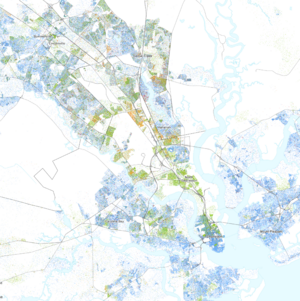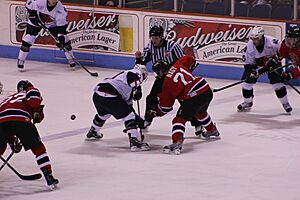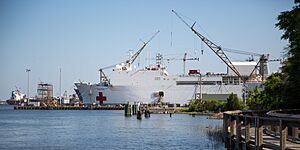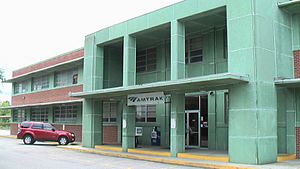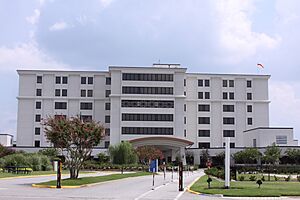North Charleston, South Carolina facts for kids
Quick facts for kids
North Charleston
|
|||||
|---|---|---|---|---|---|
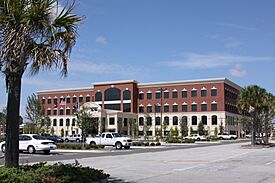
North Charleston City Hall
|
|||||
|
|||||
| Motto(s):
"A great place to live, work, and play"
"Perseverance – Progress – Prosperity" |
|||||
| Country | United States | ||||
| State | South Carolina | ||||
| Counties | Berkeley, Charleston, Dorchester | ||||
| Incorporated | June 12, 1972 | ||||
| Named for | Being north of Charleston | ||||
| Government | |||||
| • Type | Mayor–council | ||||
| Area | |||||
| • City | 81.06 sq mi (209.95 km2) | ||||
| • Land | 77.63 sq mi (201.06 km2) | ||||
| • Water | 3.43 sq mi (8.89 km2) 4.23% | ||||
| Elevation | 20 ft (6 m) | ||||
| Population
(2020)
|
|||||
| • City | 114,852 | ||||
| • Estimate
(2023)
|
121,469 | ||||
| • Rank | 248th in the United States 3rd in South Carolina |
||||
| • Density | 1,527.8/sq mi (589.9/km2) | ||||
| • Urban | 684,773 (US: 63rd) | ||||
| • Metro | 849,417 (US: 71st) | ||||
| Time zone | UTC−5 (Eastern (EST)) | ||||
| • Summer (DST) | UTC−4 (EDT) | ||||
| ZIP Codes |
29405, 29406, 29410, 29415, 29418, 29419, 29420, 29423
|
||||
| Area code(s) | 843, 854 | ||||
| FIPS code | 45-50875 | ||||
| GNIS feature ID | 1225072 | ||||
| Sales tax | 9.0% | ||||
North Charleston is a city in South Carolina, United States. It spans parts of Berkeley, Charleston, and Dorchester counties. In 2020, about 114,852 people lived here. This makes it the third-largest city in South Carolina. North Charleston is also a main city in the Charleston-North Charleston metropolitan area. This larger area had about 849,417 people in 2023.
Contents
- A Look at North Charleston's History
- Where is North Charleston? (Geography)
- Who Lives in North Charleston? (Demographics)
- What Does North Charleston Do? (Economy)
- Fun Things to Do (Arts and Culture)
- Parks and Outdoor Fun (Parks and Recreation)
- Learning in North Charleston (Education)
- Getting Around (Transportation)
- How the City Helps You (City Services)
- Famous People from North Charleston (Notable People)
- Images for kids
- See also
A Look at North Charleston's History
North Charleston has a rich history, from old plantations to becoming a modern city.
Early Days: Plantations and Farms (1680–1901)
For a long time, from the 1600s until the American Civil War, the land that is now North Charleston was covered with large farms called plantations. These farms grew important crops like rice and indigo.
Some of these famous plantations included:
- Archdale Hall Plantation: Started in 1680, it grew to almost 3,000 acres. It was known for indigo and rice. This plantation stayed in the same family for the longest time in South Carolina.
- Elms Plantation: Founded in 1682, it grew rice. Today, Charleston Southern University sits on some of its original land.
- French Botanical Garden: From 1786 to 1796, a French botanist named André Michaux owned this special garden. It was near where the Charleston International Airport is now. A parkway is named after him.
- Marshlands Plantation: This plantation started in 1682. Its main house is now listed on the National Register of Historic Places. It was moved in 1961 to keep it safe.
After the Civil War, these large plantations were divided into smaller farms. Also, factories that made fertilizer from phosphate started to appear.
Becoming a City: North Charleston's Incorporation (1901–1972)
In the early 1900s, leaders in Charleston saw the area that would become North Charleston as a great place for businesses and military sites. The first big industry was a lumber company. In 1901, the Charleston Naval Shipyard was built here. Soon after, a very large asbestos factory opened.
In 1912, a group of business people planned out new areas. One of the first was Park Circle. It was designed like an English "Garden City," with areas for homes, shops, and factories. Many streets there are still named after these early developers. During World War II, the area grew a lot as military bases and industries expanded.
For many years, people in this area wanted to have more control over their community's growth. After the Voting Rights Act of 1965, which helped all citizens vote, a vote was held on April 27, 1971, to decide if North Charleston should become a city. After some legal steps, the South Carolina Supreme Court agreed. On June 12, 1972, North Charleston officially became a city. John E. Bourne Jr. was elected its first mayor.
First Decade of Growth (1972–1982)
When North Charleston became a city, it included several neighborhoods. Within its first week, the city started setting up its government. It hired a police chief and treasurer. It also added its first industry, a plywood company. A new city park opened on Virginia Avenue.
By December 1972, North Charleston had grown a lot by adding the Naval Base, the Air Force Base, and the Charleston International Airport. This made it the fourth-largest city in South Carolina. In February 1973, the city doubled its size again through more annexations. By the end of its first year, the population had jumped from 22,000 to 53,000. By July 3, 1976, North Charleston was the third-largest city in the state.
By June 12, 1982, the city's population was 65,000. It had grown by 250 percent in just ten years!
Changes and Challenges (1982–1996)
In 1983, North Charleston was the first city in South Carolina to use a special computer system for police calls. A new hospital also opened. In 1985, plans were made for a huge shopping area called Centre Pointe.
By 1986, North Charleston had 78,000 people. A monument honoring Vietnam veterans was placed in front of City Hall. The city celebrated its 15th birthday with new shopping centers and even a man-made beach called Treasure Lake.
In September 1989, Hurricane Hugo hit the area hard, causing a lot of damage.
In 1991, Bobby Kinard became the city's second mayor. He later resigned in 1994. R. Keith Summey was then elected as the third mayor. In 2023, Reginald Burgess became the first Black mayor of North Charleston.
In 1993, new C-17 Globemaster III aircraft came to Charleston Air Force Base, bringing more jobs. The North Charleston Coliseum also opened, and the South Carolina Stingrays hockey team started playing there.
Modern Era: Redevelopment and New Industries (1996–Present)
The Charleston Naval Base was once the biggest employer of civilians in South Carolina. But after the Cold War ended, the base was set to close on April 1, 1996. This was a big loss for the area's economy. After it closed, parts of the base were rented out to different businesses and government groups. New parks, like Riverfront Park, were also created on the old base land.
In 2004, a big plan called the Noisette Community Master Plan was made for the old naval base. It aimed to bring back jobs, improve services, and make the area a better place to live.
In July 2014, plans were announced to redevelop the old Naval Hospital property into the Chicora Life Center. This center would have many social, government, and care facilities.
In October 2009, Boeing chose North Charleston for its new 787 Dreamliner aircraft assembly center. This made North Charleston one of the world's major aircraft centers, creating many new jobs.
In 2015, a sad event happened when Walter L. Scott was shot by an officer during a traffic stop. This event brought national attention to the city.
Where is North Charleston? (Geography)
North Charleston is located near the Atlantic Ocean in South Carolina. It covers about 81 square miles. Most of this area is land, with a small part being water.
The city is next to Charleston to the south and east. Other nearby cities include Hanahan, Goose Creek, Ladson, and Summerville. The Ashley River and the Cooper River form parts of the city's borders.
What's the Weather Like? (Climate)
North Charleston has a warm climate. Summers are hot and humid, while winters are mild. It gets a good amount of rain throughout the year. Snow is very rare.
Who Lives in North Charleston? (Demographics)
| Historical population | |||
|---|---|---|---|
| Census | Pop. | %± | |
| 1980 | 62,479 | — | |
| 1990 | 70,218 | 12.4% | |
| 2000 | 79,641 | 13.4% | |
| 2010 | 97,471 | 22.4% | |
| 2020 | 114,852 | 17.8% | |
| 2023 (est.) | 121,469 | 24.6% | |
| U.S. Decennial Census 2020 |
|||
North Charleston is a diverse city. As of the 2020 census, there were 114,852 people living there. The city has many different racial and ethnic groups.
Population Changes Over Time
The population of North Charleston has grown steadily over the years. In 1980, about 62,479 people lived in the city. By 2020, this number had almost doubled to 114,852. This shows how much the city has developed and attracted new residents.
What Does North Charleston Do? (Economy)
North Charleston is an important place for business and industry.
Major Industries and Companies
- Boeing: This huge aircraft company has a facility here. They build and assemble parts for the Boeing 787 Dreamliner planes. This makes North Charleston one of only three places in the world that builds large commercial aircraft.
- Global Financial Services – Charleston: This is a part of the U.S. State Department. They manage many bank accounts in over 160 countries.
- Cummins Turbo Technologies: This company makes parts for truck engines.
- Mercedes-Benz Group: They have a plant here that makes Mercedes Vans.
- Robert Bosch GmbH: This company makes parts for cars, like fuel injectors.
Military Presence
North Charleston is home to parts of the United States Military. During the Cold War, the Naval Base here was one of the largest U.S. Navy ports. It served many ships and submarines. The Charleston Naval Shipyard repaired many types of naval vessels.
In 2010, the Air Force Base and Naval Weapons Station joined together to form Joint Base Charleston. This base covers about 24,000 acres. It supports many military commands and federal agencies. It serves over 79,000 military members, civilians, and their families.
Fun Things to Do (Arts and Culture)
North Charleston has many interesting places to visit and things to see.
Museums and Historical Sites
- The H.L. Hunley Museum: This museum is at the old Naval Base. You can see the H.L. Hunley, a Civil War-era submarine. It was the first successful combat submarine in the world!
- Greater Charleston Naval Memorial: Located at Riverfront Park, this memorial honors the ships and people of the Charleston Naval Shipyard.
- North Charleston and American LaFrance Fire Museum: This museum has many old and unique fire trucks and equipment. Some pieces are from the 1700s! It also has interactive displays.
Entertainment Venues
- North Charleston Coliseum: This is one of the largest event venues in South Carolina. It hosts concerts, special events, and graduations. It is also home to the South Carolina Stingrays hockey team.
- North Charleston Performing Arts Center: This center hosts major Broadway shows and famous musical and theatrical performers.
Other Cultural Spots
- Jenkins Orphanage: Now called Jenkins Institute For Children, this place is known for helping children. It also had a famous band.
- Park Circle Film Society: This theater shows independent and documentary films. It also hosts a short film festival each year.
Parks and Outdoor Fun (Parks and Recreation)
North Charleston has many parks and green spaces for everyone to enjoy.
- Danny Jones Complex
- Ingevity-Kapstone Park
- Northwoods Park
- Park South
- Park Circle
- Quarterman Park
- Ralph M. Hendricks Park
- Riverfront Park
- Wannamaker County Park
- Wescott Park
Sports in North Charleston
The South Carolina Stingrays are the city's professional ice hockey team. They play their home games at the North Charleston Coliseum. They have been part of the ECHL since 1993.
Learning in North Charleston (Education)
North Charleston has many schools and colleges. It is served by the Charleston County School District and Dorchester School District II.
High Schools
- North Charleston High School
- R.B. Stall High School
- Academic Magnet High School
- Military Magnet Academy
- Fort Dorchester High School
Colleges and Universities
- Charleston Southern University
- Trident Technical College
- ECPI University
- The Lowcountry Graduate Center offers graduate programs from several South Carolina universities.
Getting Around (Transportation)
North Charleston has many ways to travel, by road, air, and sea.
Roads and Highways
Major highways like I-26 and I-526 run through the city. Many other important roads help people get around.
Air Travel
Charleston International Airport is located in North Charleston. It shares runways with the Charleston Air Force Base. The airport serves millions of passengers each year. Many major airlines fly from here.
Ports and Shipping
The South Carolina State Ports Authority has several facilities in North Charleston. These ports handle large container ships and other cargo. The Port of Charleston has very deep water, allowing it to handle huge ships. A new facility, the Hugh K. Leatherman Sr. Terminal, opened in 2021.
Trains and Buses
Amtrak provides passenger train service. Freight trains also run through the city. North Charleston has a bus system called CARTA. It helps people travel around the city and nearby areas.
How the City Helps You (City Services)
North Charleston provides important services to its residents.
Police Department
The North Charleston Police Department started in 1972 with 19 officers. Today, it has about 416 employees working to keep the city safe.
Fire Department
The first volunteer fire departments in the area started in the 1930s. In 1959, they merged to become the North Charleston Consolidated Fire Department. It became a paid service in 1962. Today, the North Charleston Fire Department has 13 stations and many specialized units. They respond to about 30,000 calls each year.
Healthcare
Trident Regional Medical Center is the main hospital in North Charleston. Other hospitals in the wider area also serve city residents. Emergency medical services are provided by Charleston and Dorchester counties.
Famous People from North Charleston (Notable People)
Many interesting people have connections to North Charleston.
- Carlos Dunlap, NFL defensive end
- Earl Grant, basketball player and coach
- Byron Maxwell, NFL player
- L. Mendel Rivers, former U.S. Representative
- Tim Scott, U.S. Senator for South Carolina
- Art Shell, NFL player and coach
- John Simpson, NFL player
Images for kids
See also
 In Spanish: North Charleston para niños
In Spanish: North Charleston para niños






